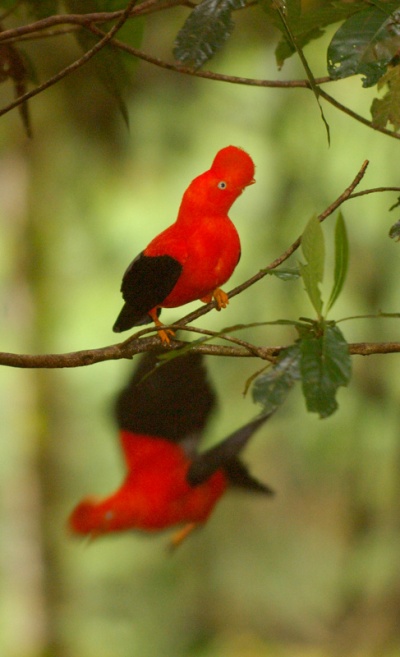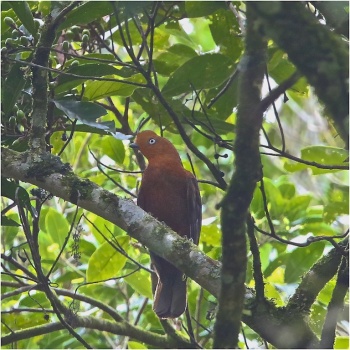(Imp sizes. More copied text disguised. Basic tidy-up. References updated) |
(Picture showing rear view. References updated) |
||
| Line 9: | Line 9: | ||
The '''female''' is browner and darker with a shorter crest. | The '''female''' is browner and darker with a shorter crest. | ||
====Variations==== | ====Variations==== | ||
| + | [[Image:Cock-of-the-Rock female .jpg|thumb|350px|right|Female, subspecies ''aequatorialis''<br />Photo by {{user|Stanley+Jones|Stanley Jones}}<br />Aguas Verdes, San Martín, [[Peru]], January 2017]] | ||
Color of the non-black plumage and of eyes differ among subspecies. | Color of the non-black plumage and of eyes differ among subspecies. | ||
==Distribution== | ==Distribution== | ||
| − | [[Venezuela]], [[Colombia]], [[Ecuador]], [[Peru]], [[Bolivia]] | + | [[South America]]: found in [[Venezuela]], [[Colombia]], [[Ecuador]], [[Peru]], [[Bolivia]] |
==Taxonomy== | ==Taxonomy== | ||
A member of the [[:Category:Cotingidae|cotinga family]] and one of the two species in the [[:Category:Rupicola|genus ''Rupicola'']]<br /> | A member of the [[:Category:Cotingidae|cotinga family]] and one of the two species in the [[:Category:Rupicola|genus ''Rupicola'']]<br /> | ||
====Subspecies==== | ====Subspecies==== | ||
| − | [[Image: | + | [[Image:IMG 13921.jpg|thumb|350px|right|Photo by {{user|jeffworman|jeffworman}}<br />Refugio Paz de las Aves, near Mindo, [[Ecuador]], January 2017]] |
Four subspecies are recognized,<sup>[[#References|[1]]]</sup> | Four subspecies are recognized,<sup>[[#References|[1]]]</sup> | ||
*''R.p. sanguinolentus'': | *''R.p. sanguinolentus'': | ||
| Line 44: | Line 45: | ||
</gallery> | </gallery> | ||
==References== | ==References== | ||
| − | #{{Ref- | + | #{{Ref-Clements6thAug17}}#Handbook of the Birds of the World Alive (retrieved March 2017) |
#BF Member observations | #BF Member observations | ||
#Wikipedia | #Wikipedia | ||
Revision as of 00:26, 10 November 2017
- Rupicola peruvianus
Identification
30·5–32 cm (12-12½ in). A medium-sized passerine
- Scarlet or orange plumage
- Black wings and tail
- Bushy fan-shaped crest on the forehead lends an unusual shape to the head, and makes identification even easier (although the coloration is usually enough).
The female is browner and darker with a shorter crest.
Variations
Color of the non-black plumage and of eyes differ among subspecies.
Distribution
South America: found in Venezuela, Colombia, Ecuador, Peru, Bolivia
Taxonomy
A member of the cotinga family and one of the two species in the genus Rupicola
Subspecies
Four subspecies are recognized,[1]
- R.p. sanguinolentus:
- R.p. aequatorialis:
- R.p. peruvianus:
- Andes of central Peru (San Martín to Junín)
- R.p. saturatus;
- Andes of south-eastern Peru (Cusco and Puno) and western Bolivia
Rupicola peruvianus has in the past been called Rupicola peruviana.
Habitat
Gorges and ravines in cloud forest on both slopes of the Andes. Roadside, disturbed secondary rain forest 1,219 m
Behaviour
Diet
The diet consists of a variety of fruits, large insects and small invertebrates.
Breeding
Males are polygamous and display in communal leks. The females build shallow nests with mud and plant material on the walls of rocks, hence the common name.
In Culture
This is the national bird of Peru.
Gallery
Click on photo for larger image
Adult female
Photo by Peter R. Bono
Along Manu Road, at lek just above Cock-of-the-Rock Lodge, (approx. 1450m), Peru, August 2002
References
- Clements, J. F., T. S. Schulenberg, M. J. Iliff, D. Roberson, T. A. Fredericks, B. L. Sullivan, and C. L. Wood. 2017. The eBird/Clements checklist of birds of the world: v2017, with updates to August 2017. Downloaded from http://www.birds.cornell.edu/clementschecklist/download/
- Handbook of the Birds of the World Alive (retrieved March 2017)
- BF Member observations
- Wikipedia
Recommended Citation
- BirdForum Opus contributors. (2024) Andean Cock-of-the-rock. In: BirdForum, the forum for wild birds and birding. Retrieved 26 April 2024 from https://www.birdforum.net/opus/Andean_Cock-of-the-rock







